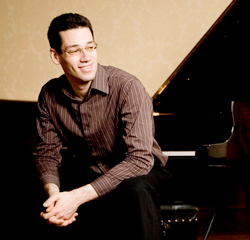by Daniel Hautzinger
 Beethoven is a big part of Jonathan Biss’s life. That might be an obvious assertion to make about a touring classical pianist, but the great German master looms perhaps larger over Biss than for most. In his case, Beethoven is the subject of recordings, writings, a commissioning project, and even a college course. On January 20 in the University of Akron’s E.J. Thomas Performing Arts Hall, you can hear one aspect of his devotion to the composer, when he will present a program for the Tuesday Musical Association that begins and ends with Beethoven.
Beethoven is a big part of Jonathan Biss’s life. That might be an obvious assertion to make about a touring classical pianist, but the great German master looms perhaps larger over Biss than for most. In his case, Beethoven is the subject of recordings, writings, a commissioning project, and even a college course. On January 20 in the University of Akron’s E.J. Thomas Performing Arts Hall, you can hear one aspect of his devotion to the composer, when he will present a program for the Tuesday Musical Association that begins and ends with Beethoven.
“I’m recording the complete piano sonatas right now, so the majority of my programs have Beethoven on them,” Biss said over the phone. Such a matter-of-fact statement about his recording project belies the magnitude of that task. Beethoven’s thirty-two sonatas are some of the richest works in the repertoire, by turns profound, antic, inscrutable, and forthright, and almost always virtuosic as well. It takes nine discs to contain all the music, at least for Biss’s recording project, which will take nine years. The fourth volume, which includes op. 2, no. 1, op. 10 no. 2, op. 49, no. 1, and the “Appassionata,” op. 57, will be released January 27.
Op. 2, no. 1 is Beethoven’s first piano sonata, and it opens both the new recording and Biss’s concert in Akron. “I decided for this program that I would play two Beethoven sonatas, not just an early one but the very first one, and then one of the very last ones, op. 101, at opposite ends of the program,” he said. “I liked the idea of starting with Beethoven and then going off on all of these wild but not unrelated adventures and coming back to him and seeing where he ended up.”
Those “wild adventures” explore three examples of German music in the wake of Beethoven: Schoenberg’s Sechs Kleine Klavierstücke, op. 19, Schumann’s Waldszenen, and Berg’s op. 1 sonata. “Beethoven was the fundament of the culture those composers grew up with. He challenged so many of the basic tenets of music that were in place at the beginning of his life, which inspired all the composers who came in subsequent generations to go even further. It’s difficult to name almost any European composer who’s not reacting to him in some way,” Biss said.
Just as Beethoven influenced so many composers, Biss believes that “the late pieces of Schumann anticipate early Berg in an amazing way. With Schumann you so often have this dreamlike, almost hallucinatory quality, as if he were transcribing some very inner monologue. I feel that with Berg as well.”
Having detoured through Schoenberg and the inner monologues of Schumann and Berg, Biss will return to Beethoven — albeit Beethoven with a drastically changed style. “The difference between op. 2 and op. 101 is enormous and fascinating,” he said. “I think that one of the reasons the Beethoven sonatas have captured our attention so much is that they’re so different from one another.”
Biss has the authority to make such a claim about Beethoven and the sonatas. Not only is he in the midst of recording them, but he has also designed a massive open online course (MOOC) for the Curtis Institute of Music entitled “Exploring Beethoven’s Piano Sonatas,” which relaunched earlier this month. He has written Beethoven’s Shadow, an Amazon Kindle Single about some of his experiences with Beethoven. And he has designed a commissioning project that will combine Beethoven’s piano concertos with new music —more details coming in April.
Performing new concertos is no longer a new prospect for Biss, who commissioned one from Bernard Rands and premiered it last year. “It’s a really scary thing to commission a work,” he said, “because you’re going to put a huge amount of effort into learning it, but really don’t know what the fruits of your labor are going to be. It is kind of a magical experience to hear the piece become a living, breathing thing.” Some of the fruits of Biss’s labor are already evident: with his efforts, Beethoven’s music continues to live and breathe as well.
Published on ClevelandClassical.com January 12, 2015.
Click here for a printable copy of this article


